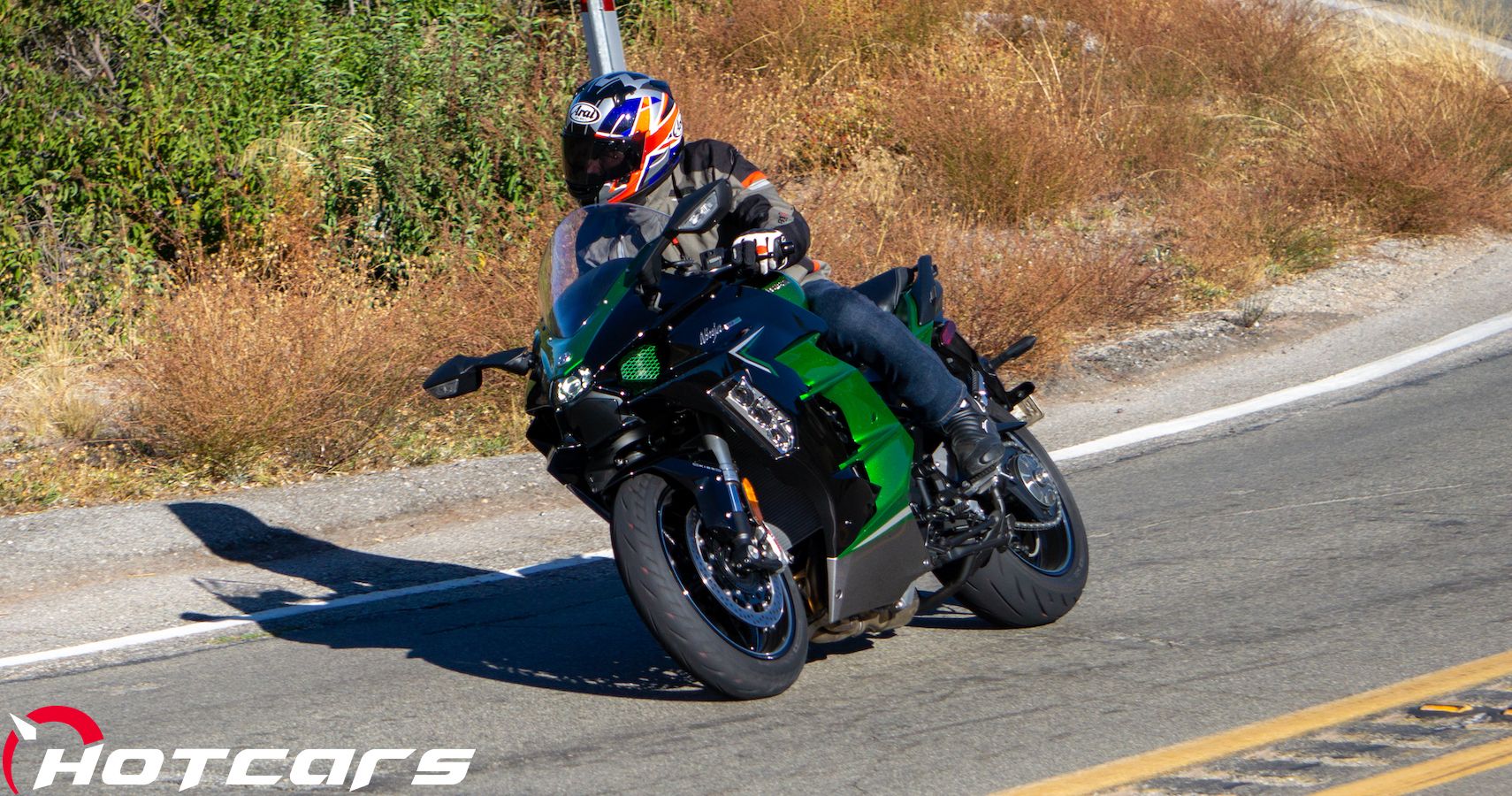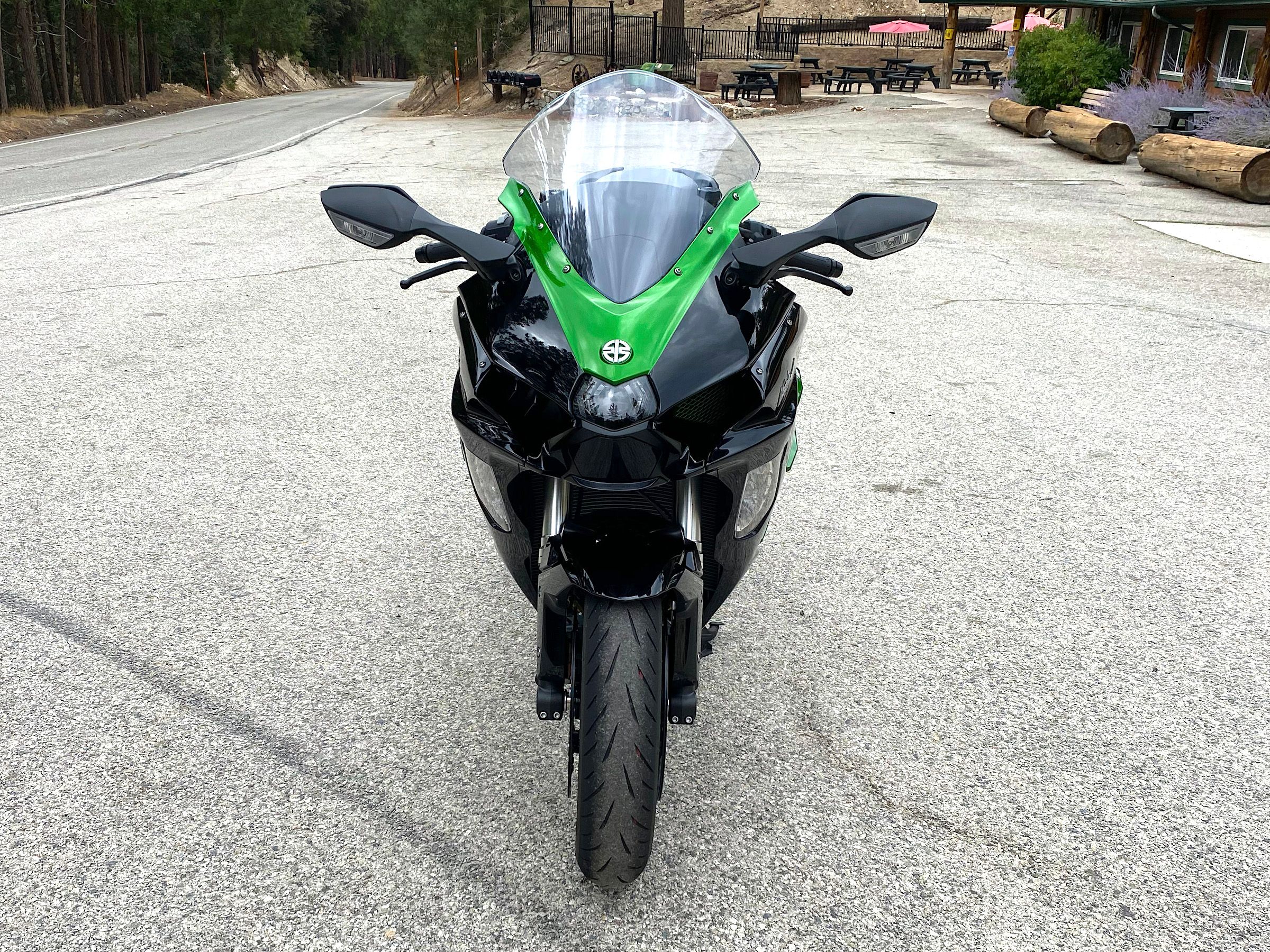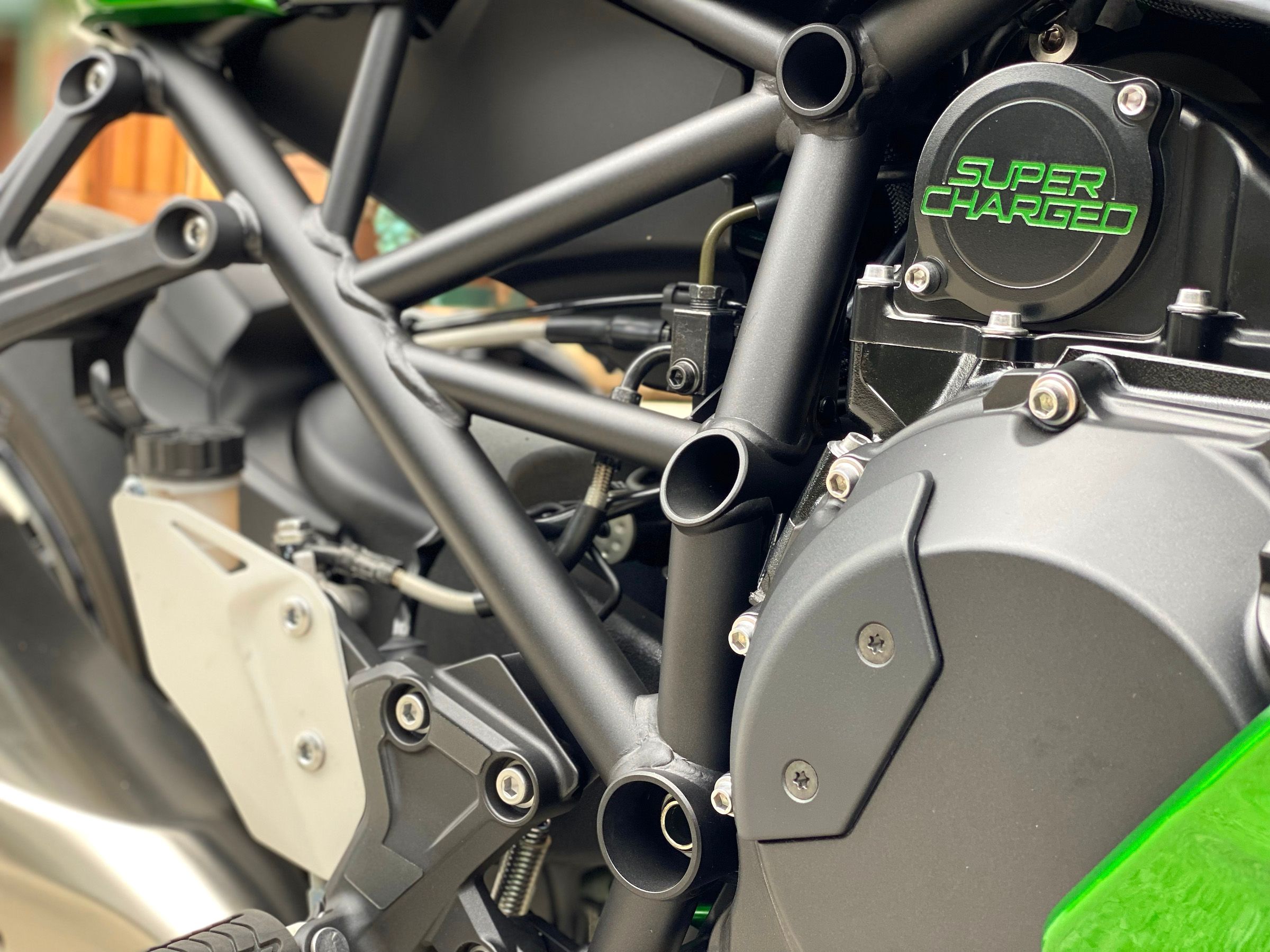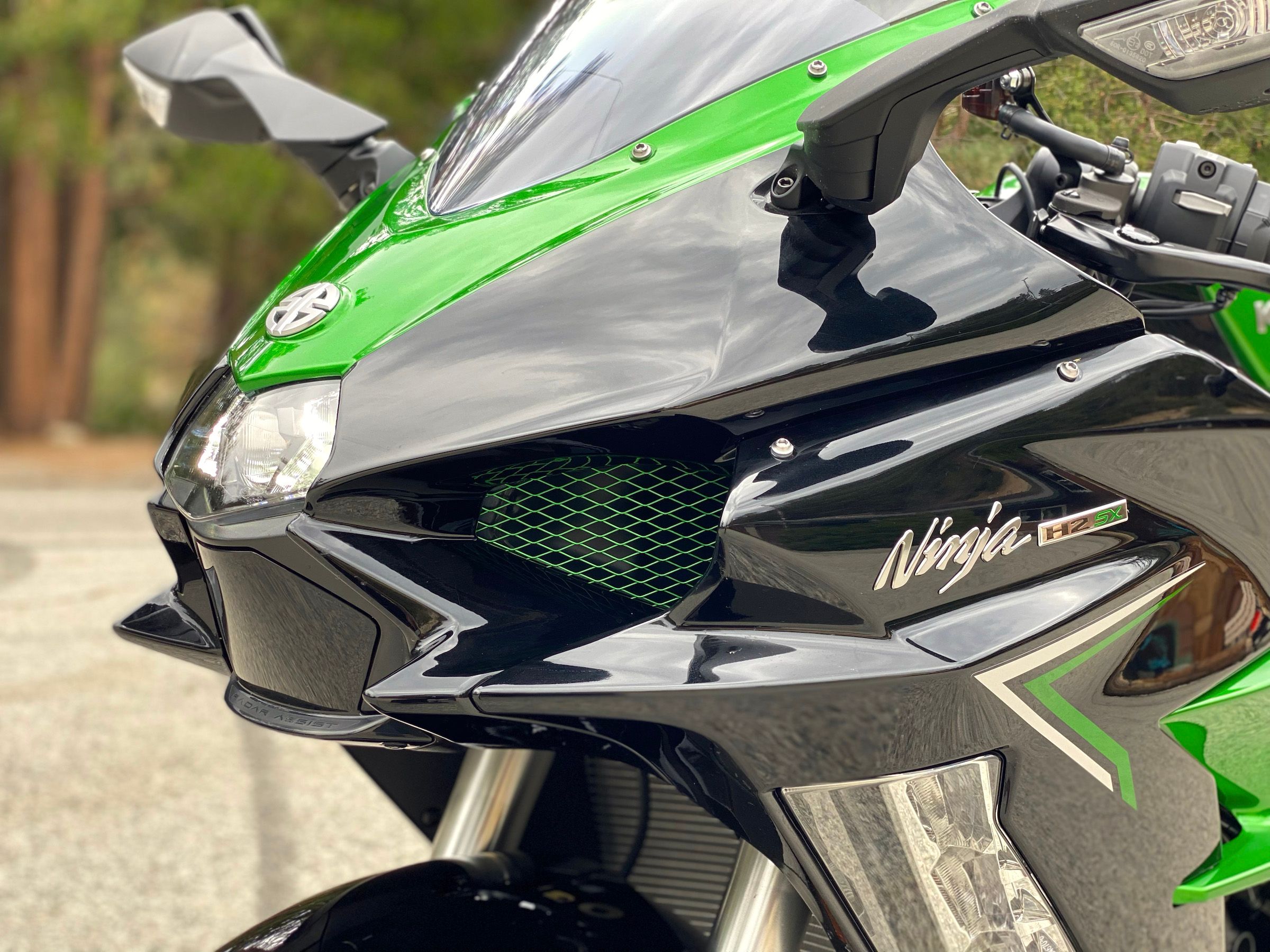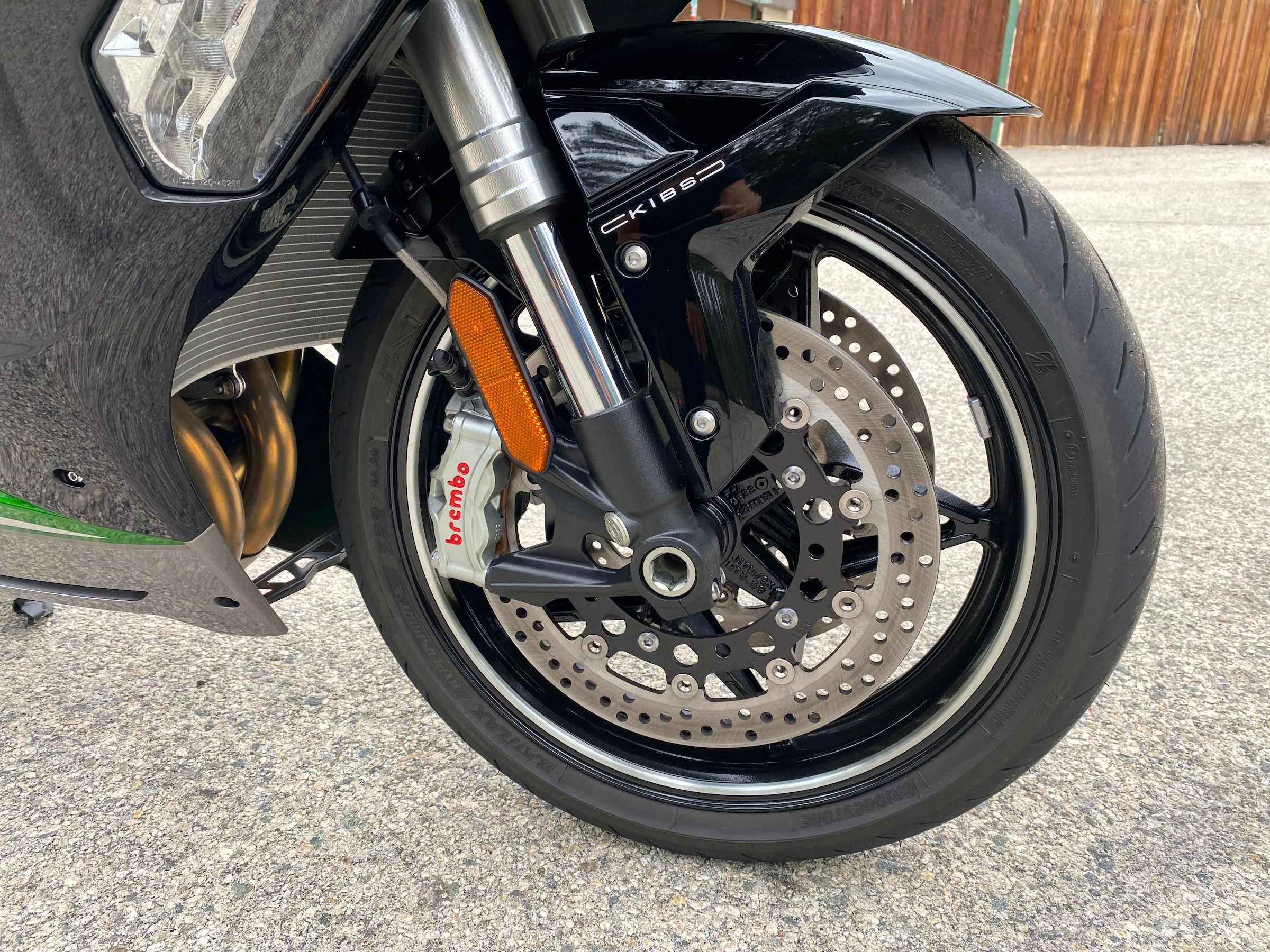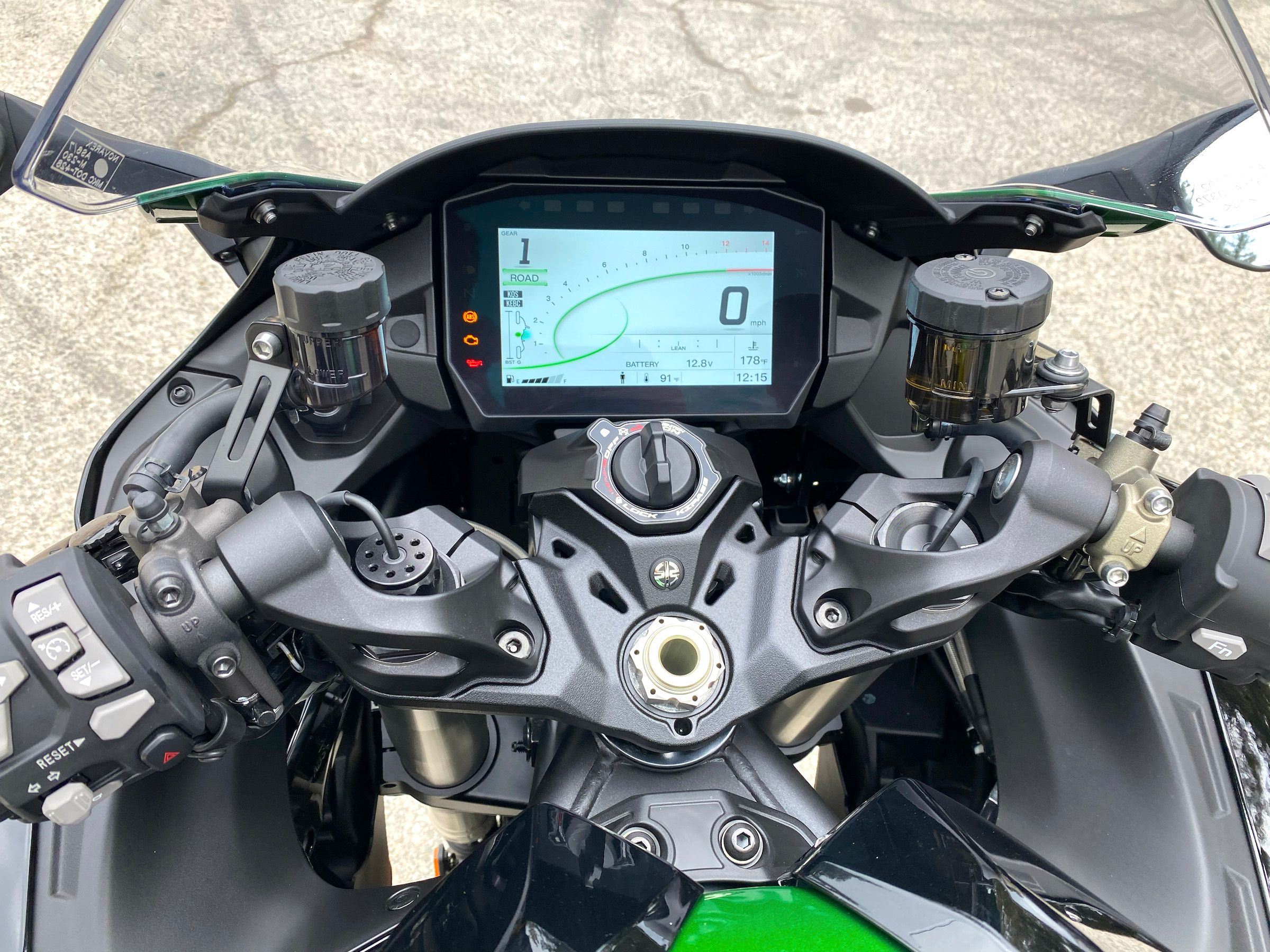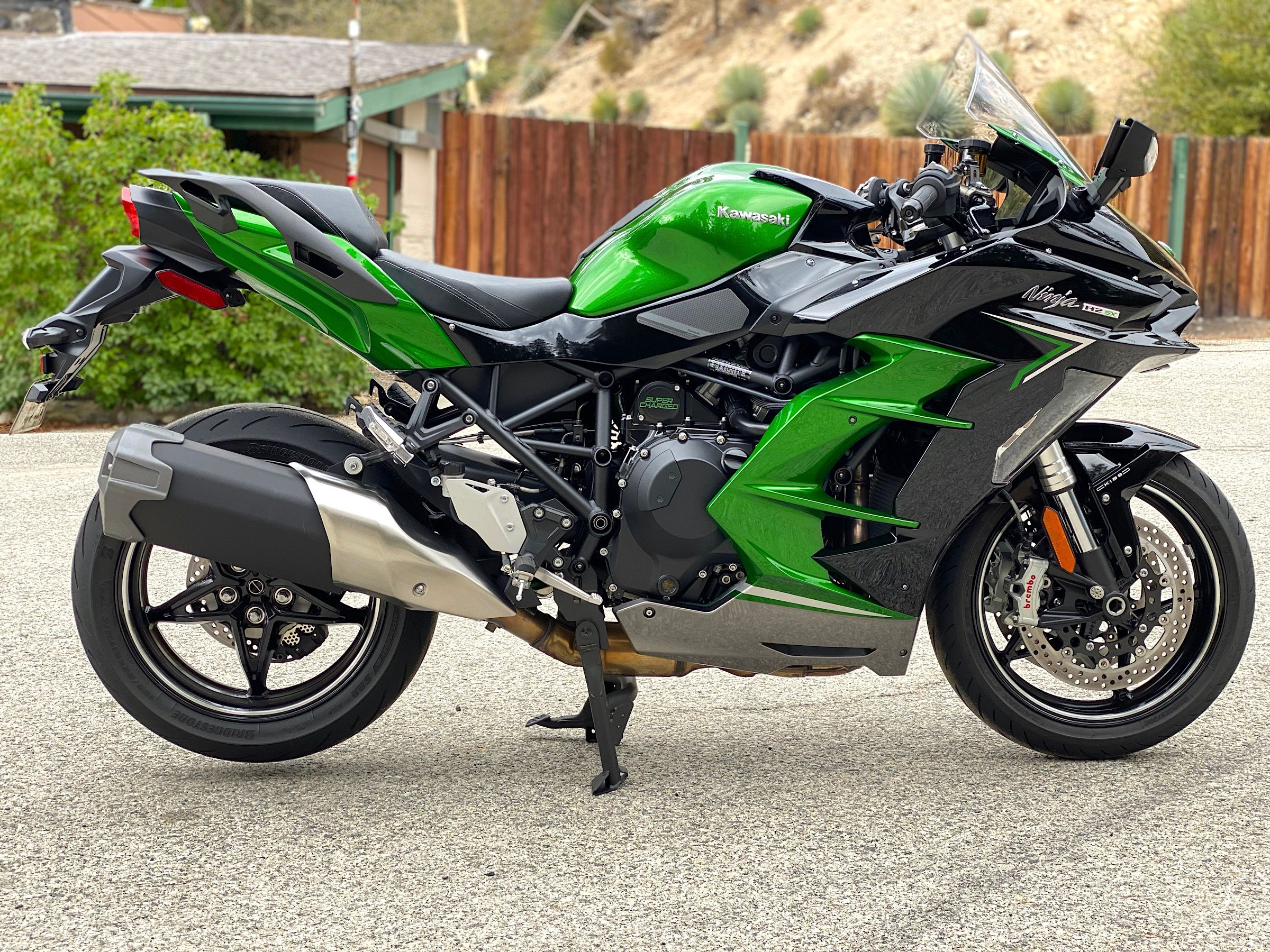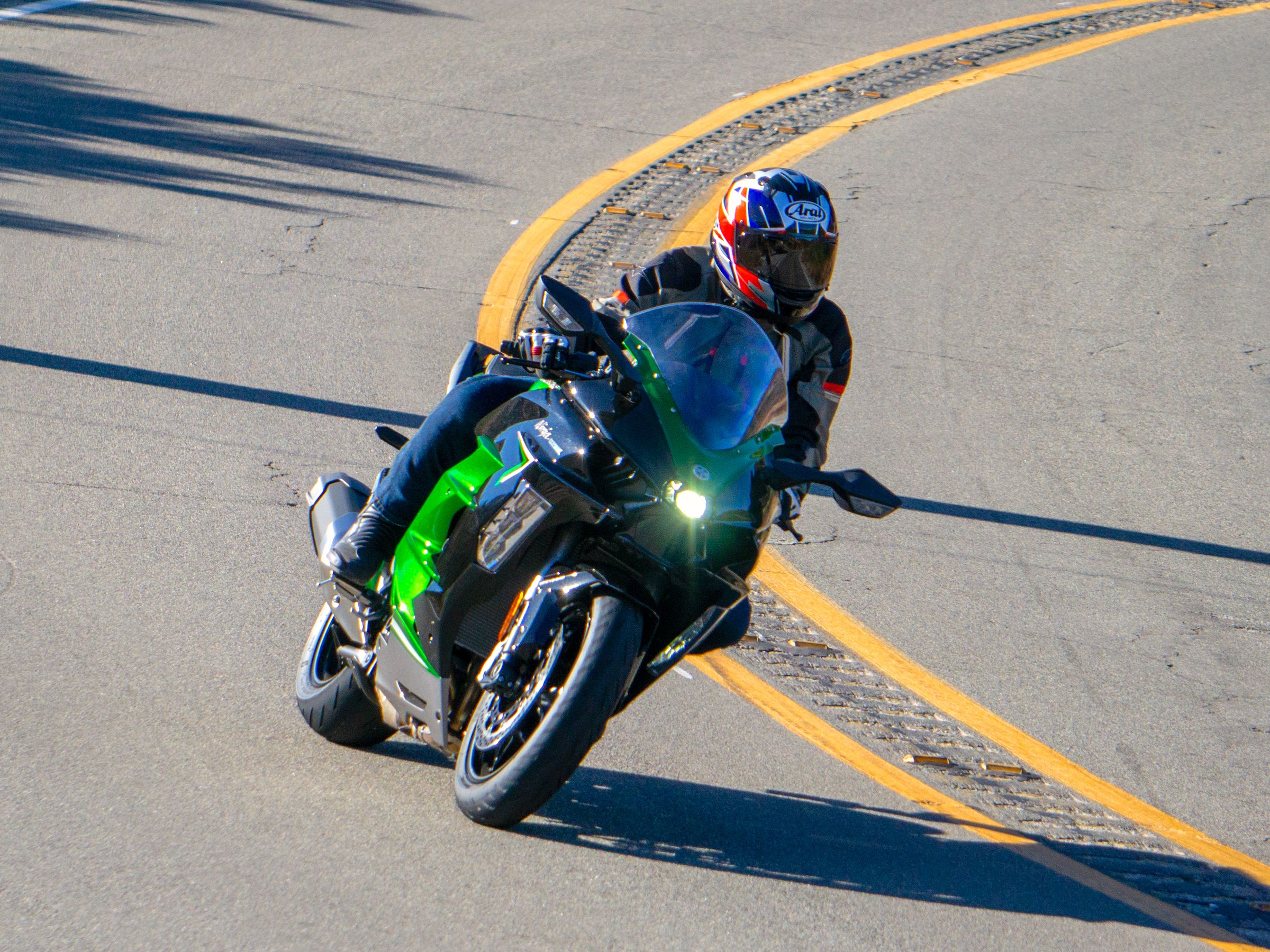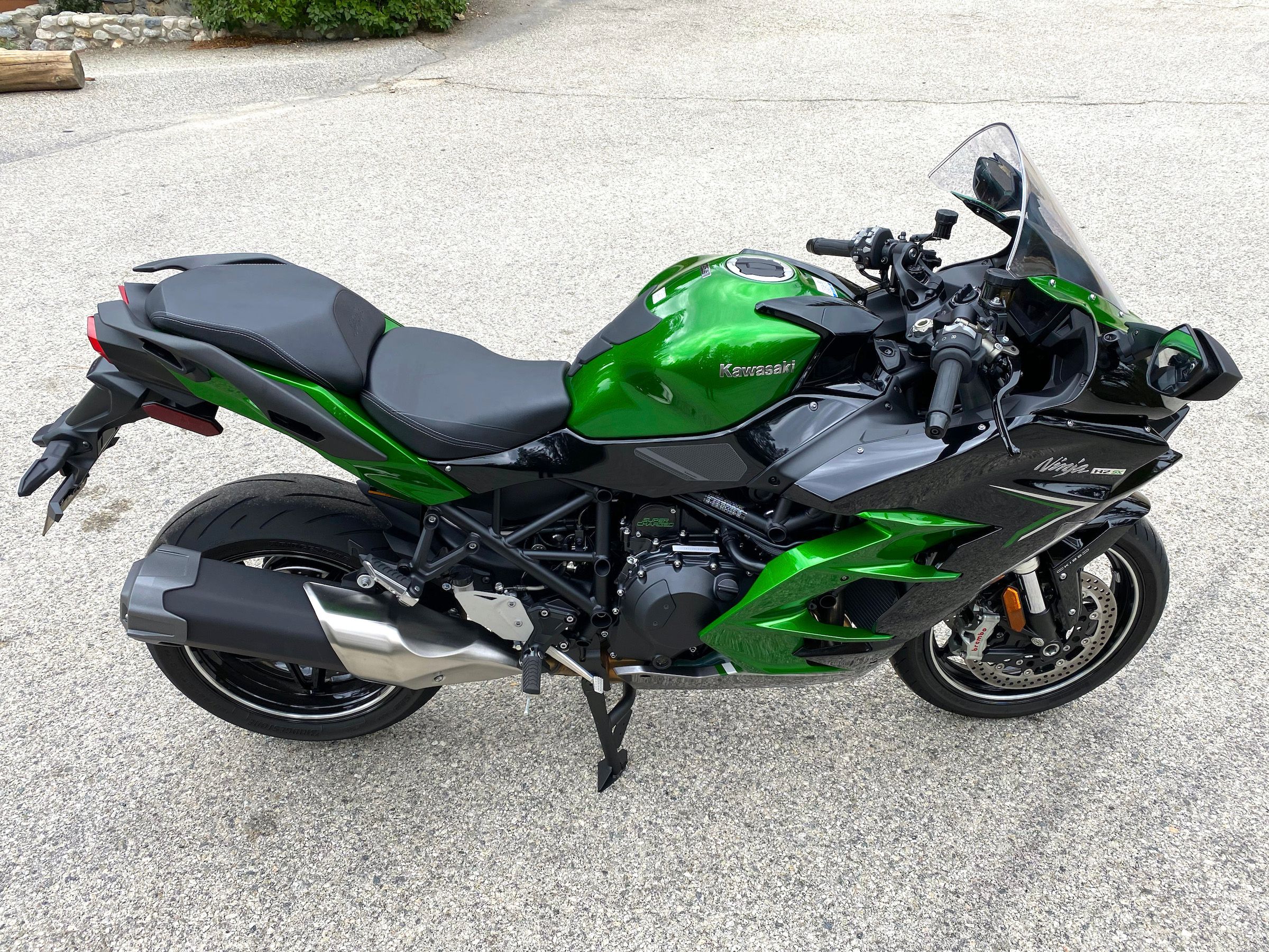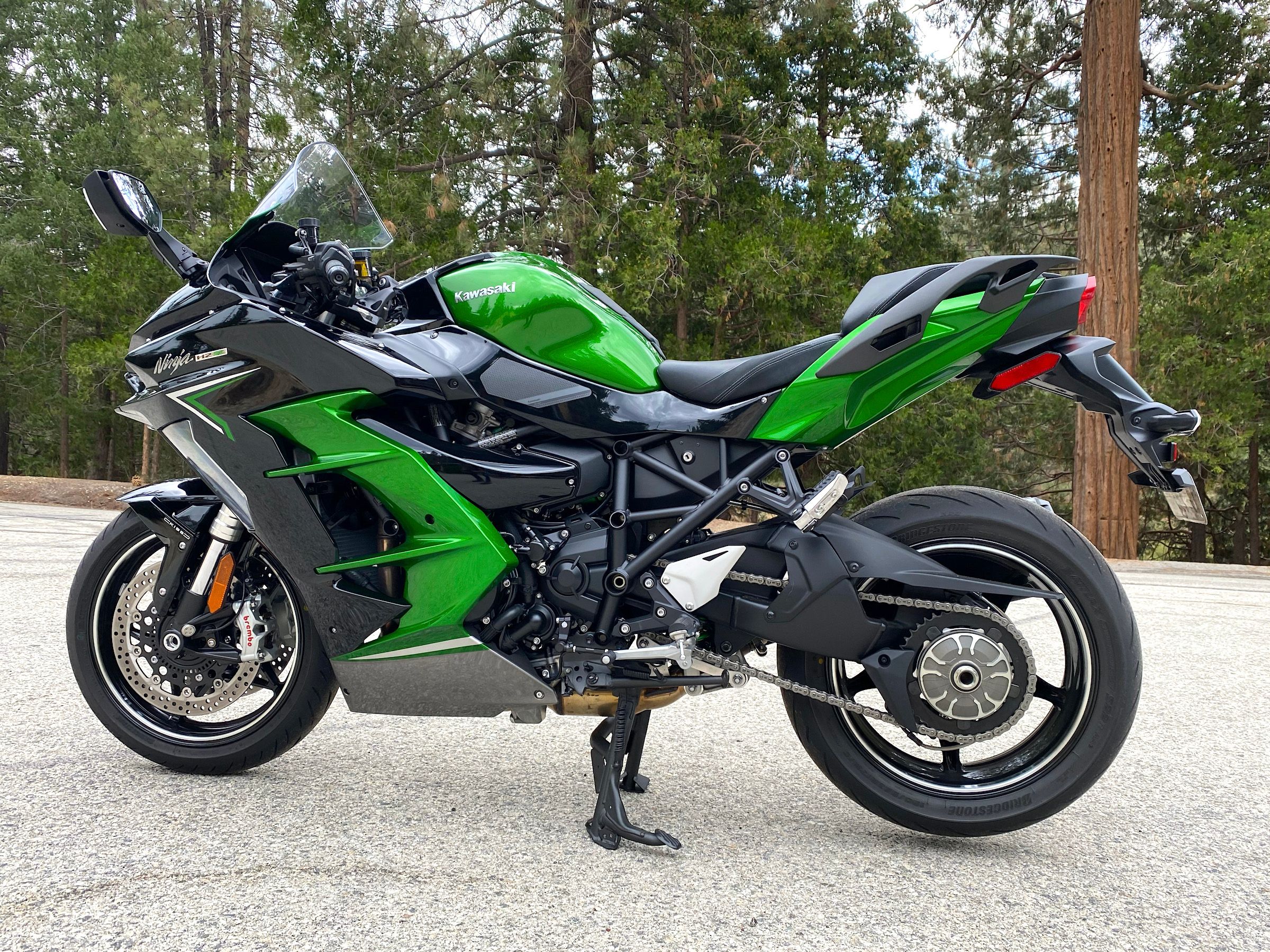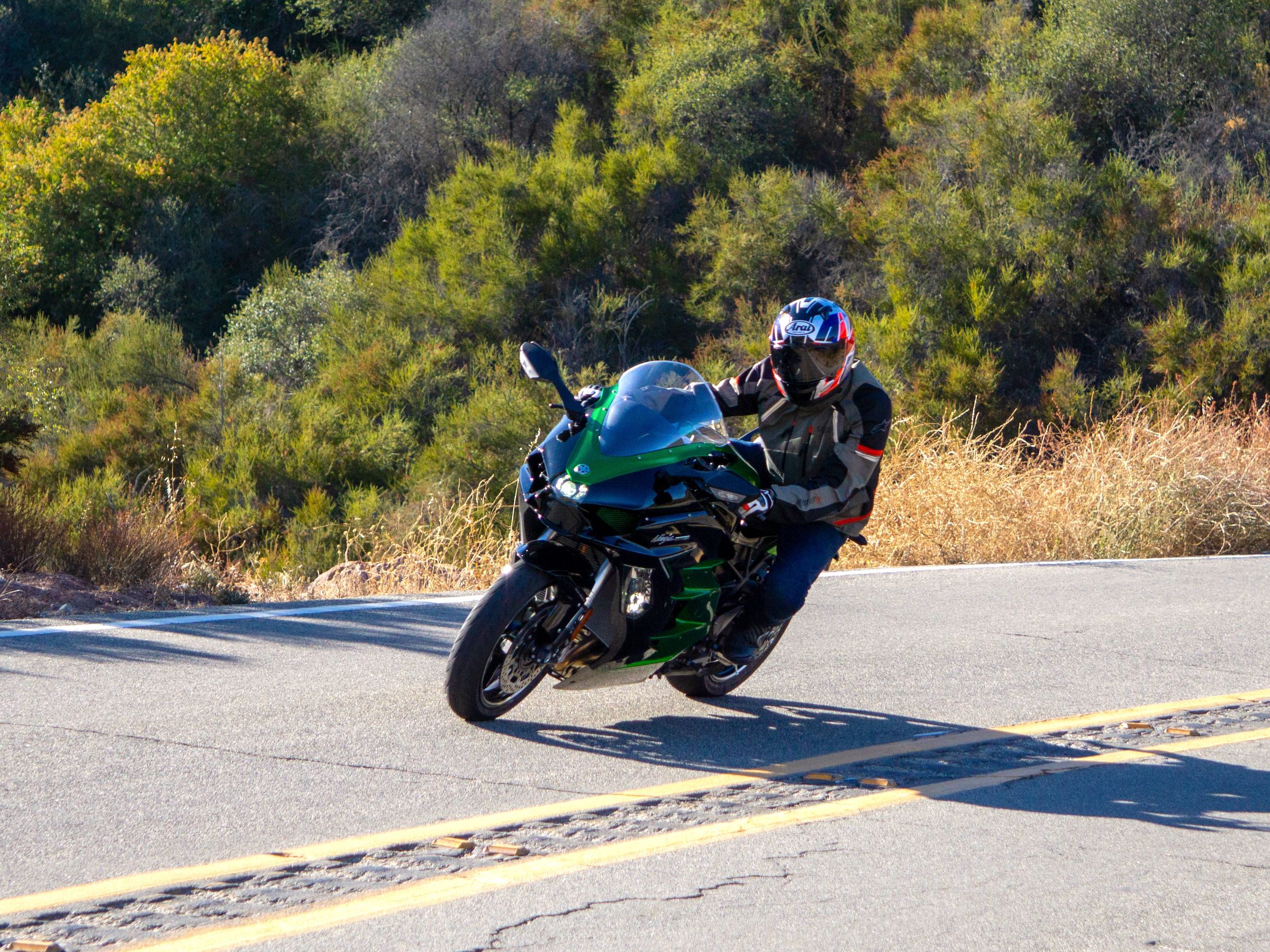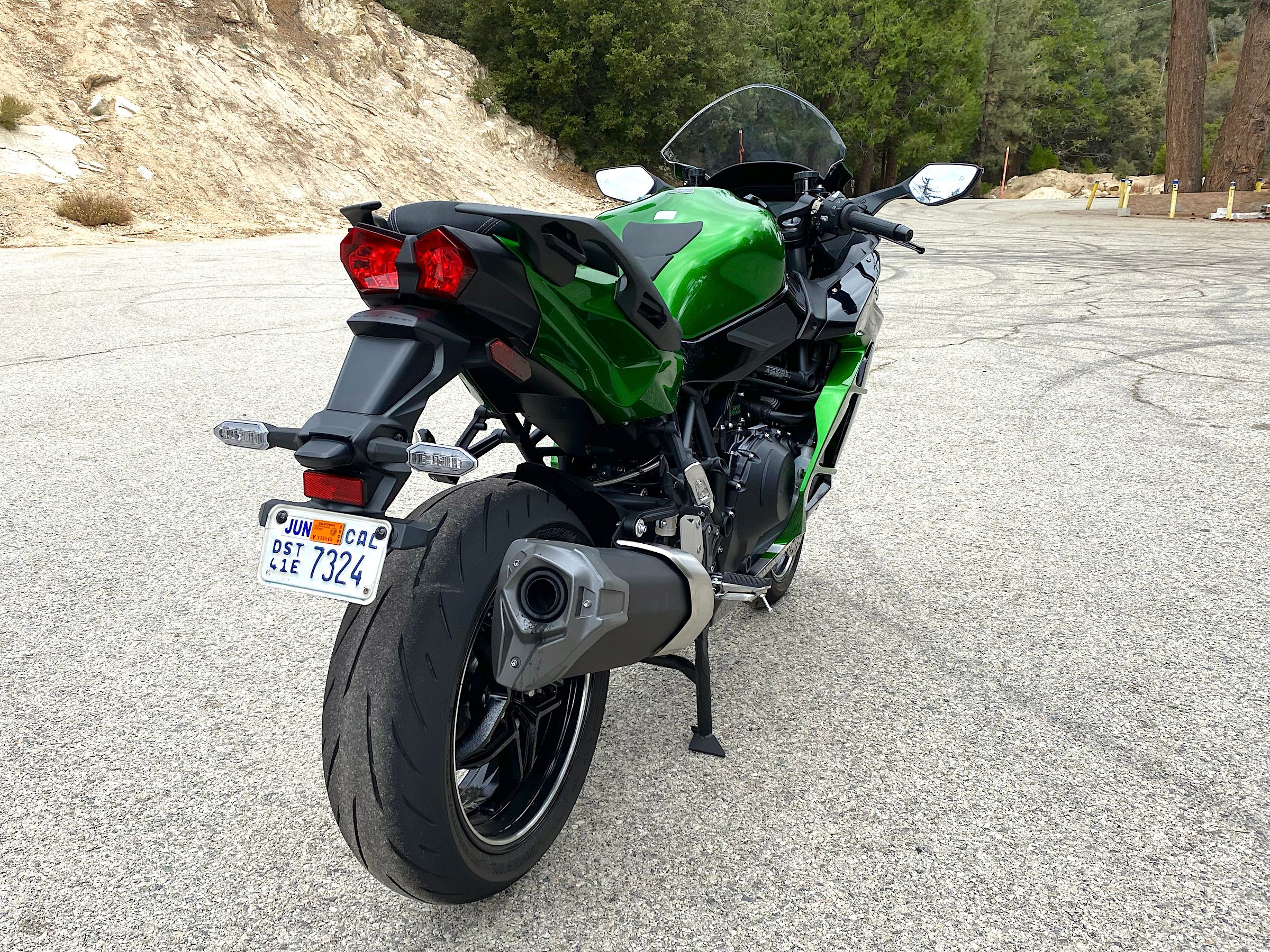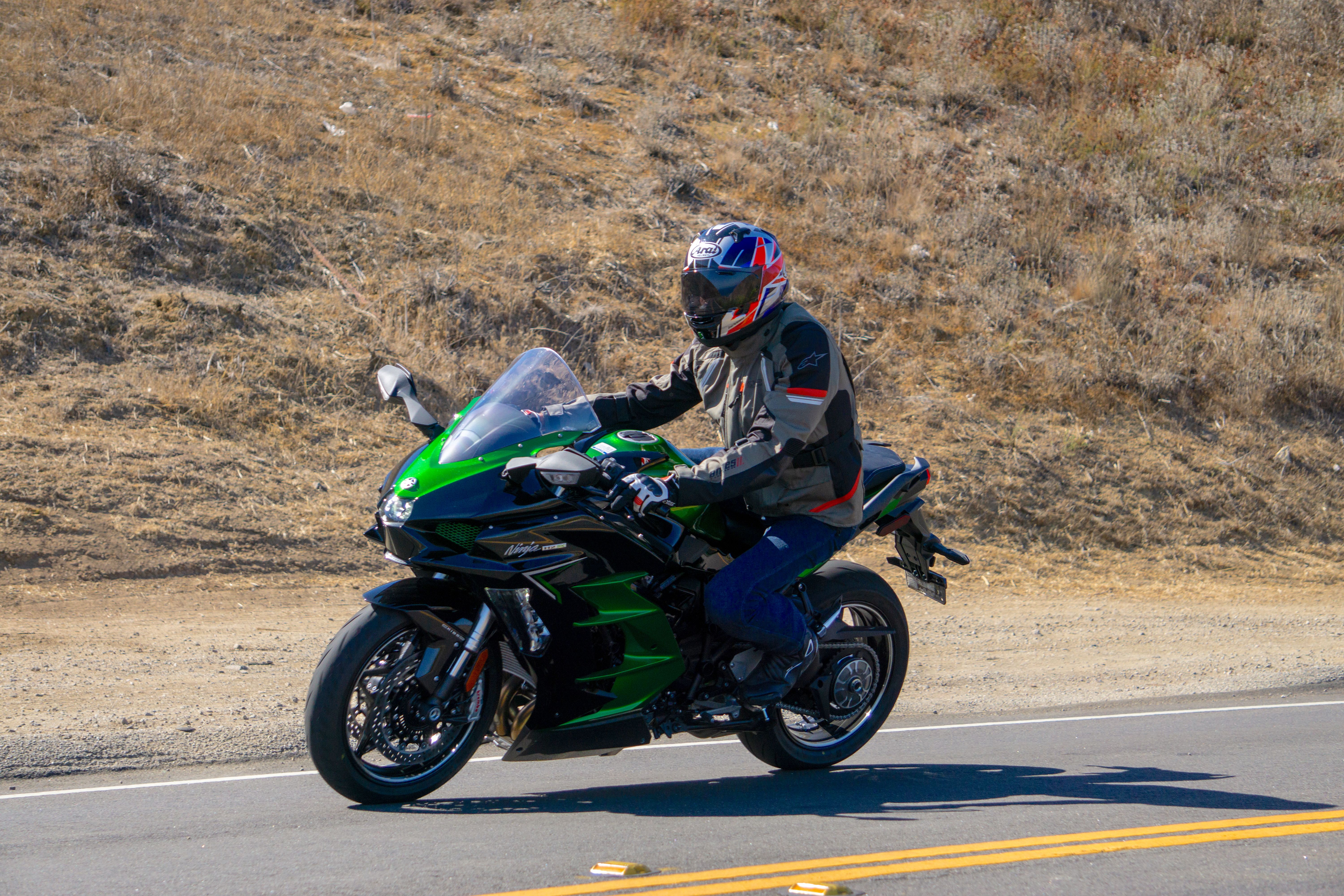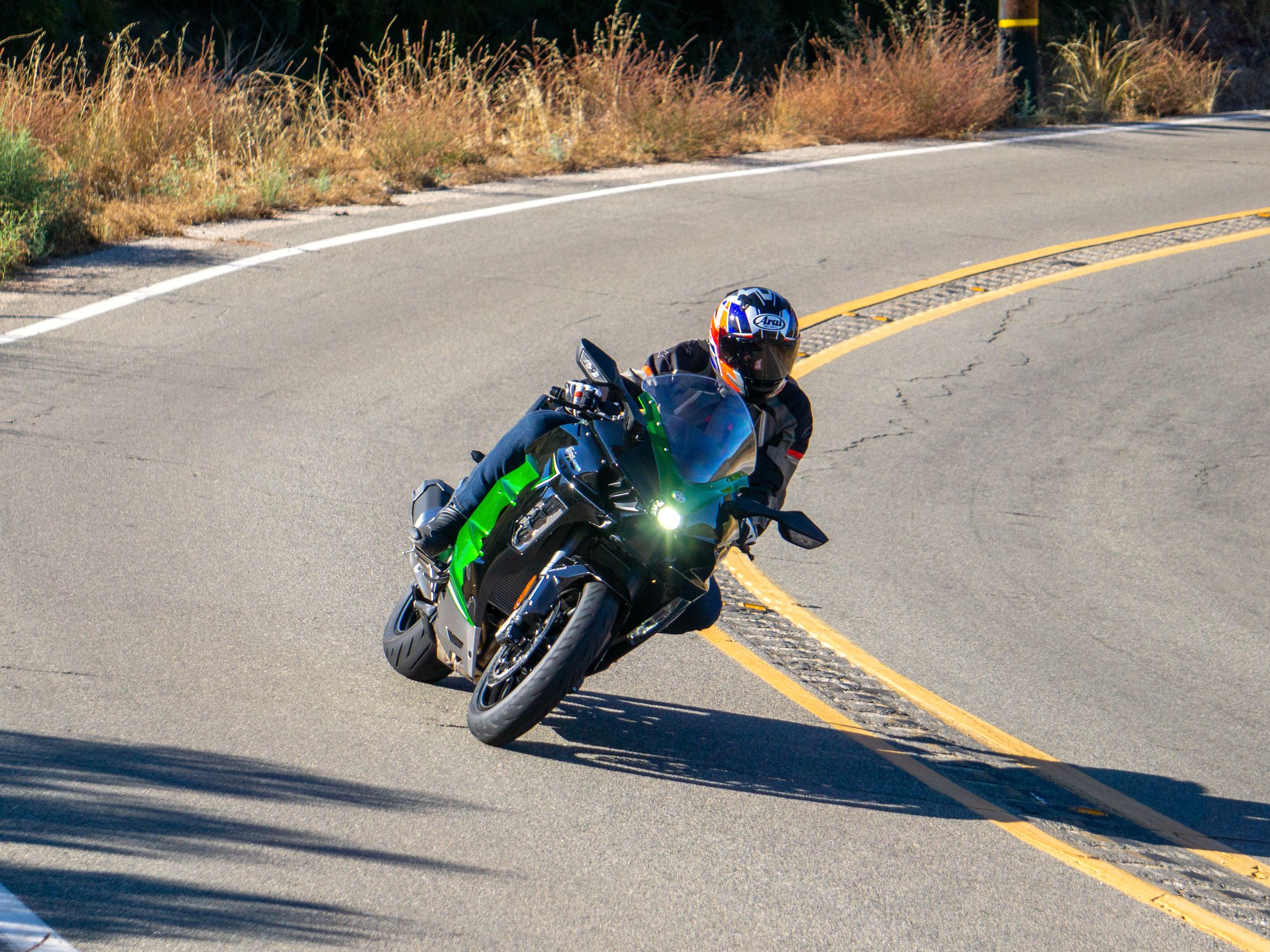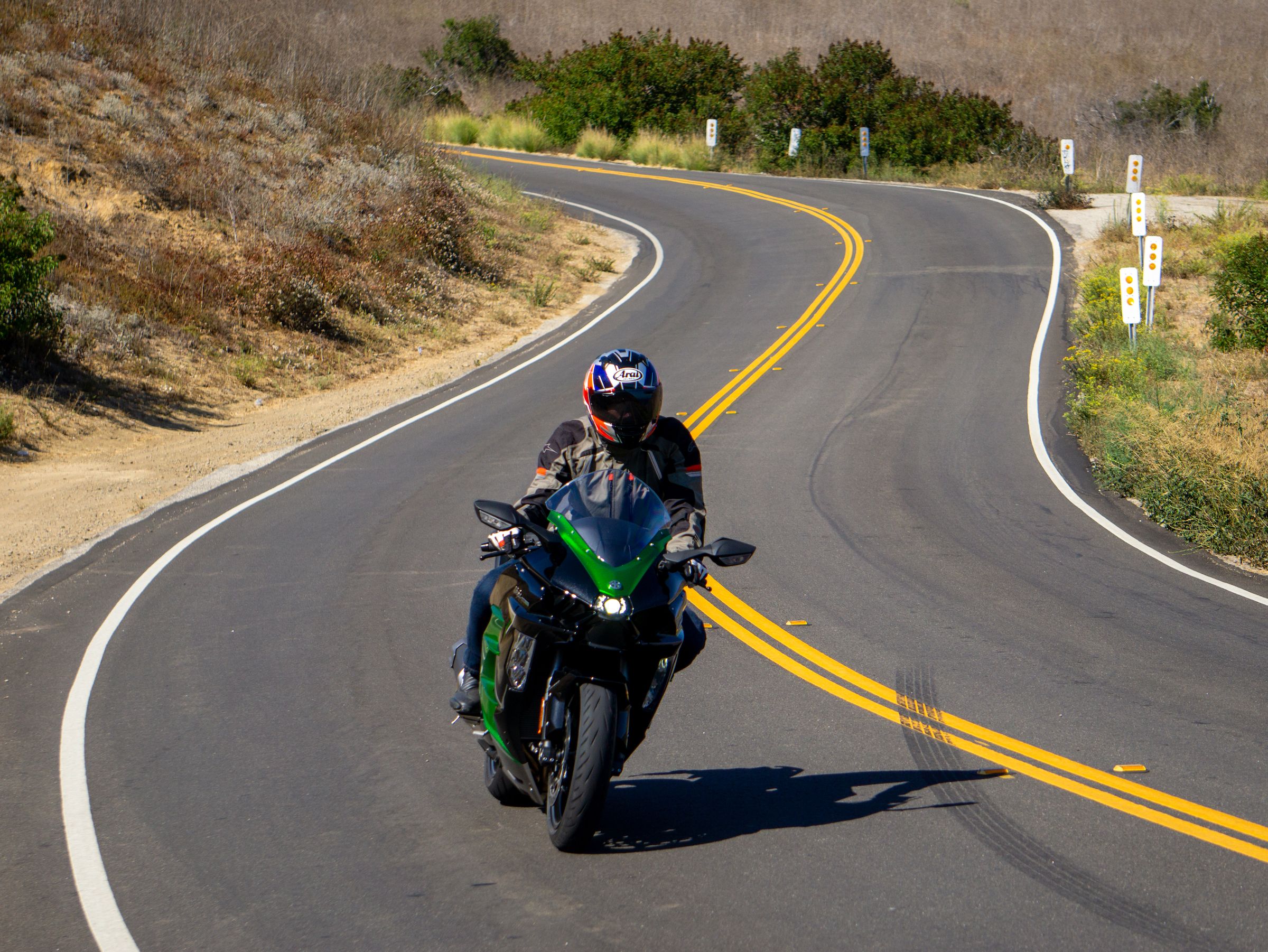Audacious engineers have endeavored to build blowers into motorcycle engines from the moment forced induction became a thing. BMW and Brough Superior were among the pioneers of supercharging motorcycle engines, and a BMW Type 255 Kompressor won the Isle of Man TT in 1936. After WWII, the killjoys at FIM banned forced induction from road racing, effectively ending manufacturer development. Until the late ‘70s, when Kawasaki, whose H2 series of insane two-strokes had cemented a reputation for building outrageous machines, decided its flagship Z1000 needed an extra boost. The Kawasaki Z1R-TC, released in 1978, was the first semi-production turbocharged motorcycle. Modified by independent specialists, Turbo Cycle, the new Z-turbo sold through Kawasaki’s dealer network.
All four big Japanese manufacturers would join the fray, and the 1980s produced a rash of new turbocharged models: the Honda CX 500 and 650 Turbo, Yamaha’s XJ 650 Seca Turbo, the Suzuki XN 85 Turbo, and finally, Kawasaki’s (all in-house) GPZ750 Turbo. Sadly, owners of these innovative bikes soon discovered that chronic turbo lag required the mental agility of a chess master to anticipate their immense, yet erratic, power delivery. None of the new bikes would see lasting production. Even modern turbochargers, which are less prone to lag, heat the air they compress to a degree where it requires an intercooler (and all the associated plumbing), making them impractical for standard motorcycle applications. Nevertheless, Kawasaki persisted in chasing the forced induction dream and, in 2015, released its first supercharged bike. The outrageous H2 series was back, only ridable this time, as well as fast. The 2022 Ninja H2 SX is the most ridable of them all, and despite a sport-touring engine tune, trust us, it is still as quick as you could ever want.
2022 Kawasaki Ninja H2 SX SE
- Supercharged Inline-Four
- Super Fast Dog-Ring Racing Transmission
- Brembo Master Cylinder And Stylema Calipers
- Wide-Angle Radar Fore And Aft
- Advanced Suite Of Rider Aids And Modes
- Wireless Smartphone Connectivity
- Semi-Active Showa Fork And Monoshock
- Heated Grips
- Model: Ninja H2 SX SE
- Engine/Motor: Supercharged, Liquid-Cooled, 988cc, DOHC 16-Valve Inline-Four
- Horsepower: 197
- Torque: 101 ft-lbs @ 9500 rpm
- Drivetrain: X-Ring Sealed Chain
- Transmission: 6-speed, Manual, Return Shift, Dog Ring
- Astonishing acceleration throughout the gear range
- Possibly the smoothest inline-four ever to power a motorcycle
- An ocean of torque for effortless riding and seemingly endless grunt
- Surprisingly agile despite its weight
- Accessible seat height and manners
- Exceptional ride characteristics afforded by semi-active suspension
- New seat and heated grips add touring comforts
- Keyless ignition and immobilization
- Heavy for its class at 590 pounds
- Quickshifter is clunky at lower revs (possibly due to the dog-ring transmission)
Engine And Performance
The superb, supercharged 998cc, liquid-cooled, DOHC, 16-valve, inline-four engine produces 197 horsepower, supplemented by a mighty 101 foot-pounds of torque. Tuned for a more relaxed riding style, the SX SE delivers better low-mid range power, and although it is less mental than its 228 horsepower hyper-sport H2 cousin, you will likely run out of road long before it runs out of breath. New cam-timing helps to maximize performance and reduce emissions. A redesigned exhaust system eliminates the pre-silencer chamber and uses a bigger can, promising reduced exhaust gas restriction and improved torque. A resin silencer added to the secondary air inlet also reduces intake noise.
Kawasaki’s planetary drive, centrifugal supercharger is brilliantly simple and does not require an intercooler. Compressing air causes it to heat up, reducing its oxygen content, which makes it less combustible. As a result, most forced induction systems require an intercooler to reduce the air temperature before it reaches the combustion chamber. However, the H2’s supercharger design can achieve very high impeller speeds while maintaining a surprisingly high thermal efficiency, adding noticeable boost with minimal weight and complexity.
Inherited from the racetrack, the H2 uses a dog ring gearbox, possibly the only production bike to do so. Dog rings allow for very quick gear shifting, and the stacked design is extremely compact and lightweight. Instead of a synchromesh, the H2’s transmission relies on clever electronics and improved clutch operation to manage gear shifts. Activating the quickshifter from the menu provides up and down, clutchless shifting, and the dog-ring design likely accounts for its clunky feel. An auto blipper helps with the downshifts and the system works fine when pushing the envelope (precisely when a quickshifter makes sense) but doesn’t respond well to short shifting.
Chassis And Suspension
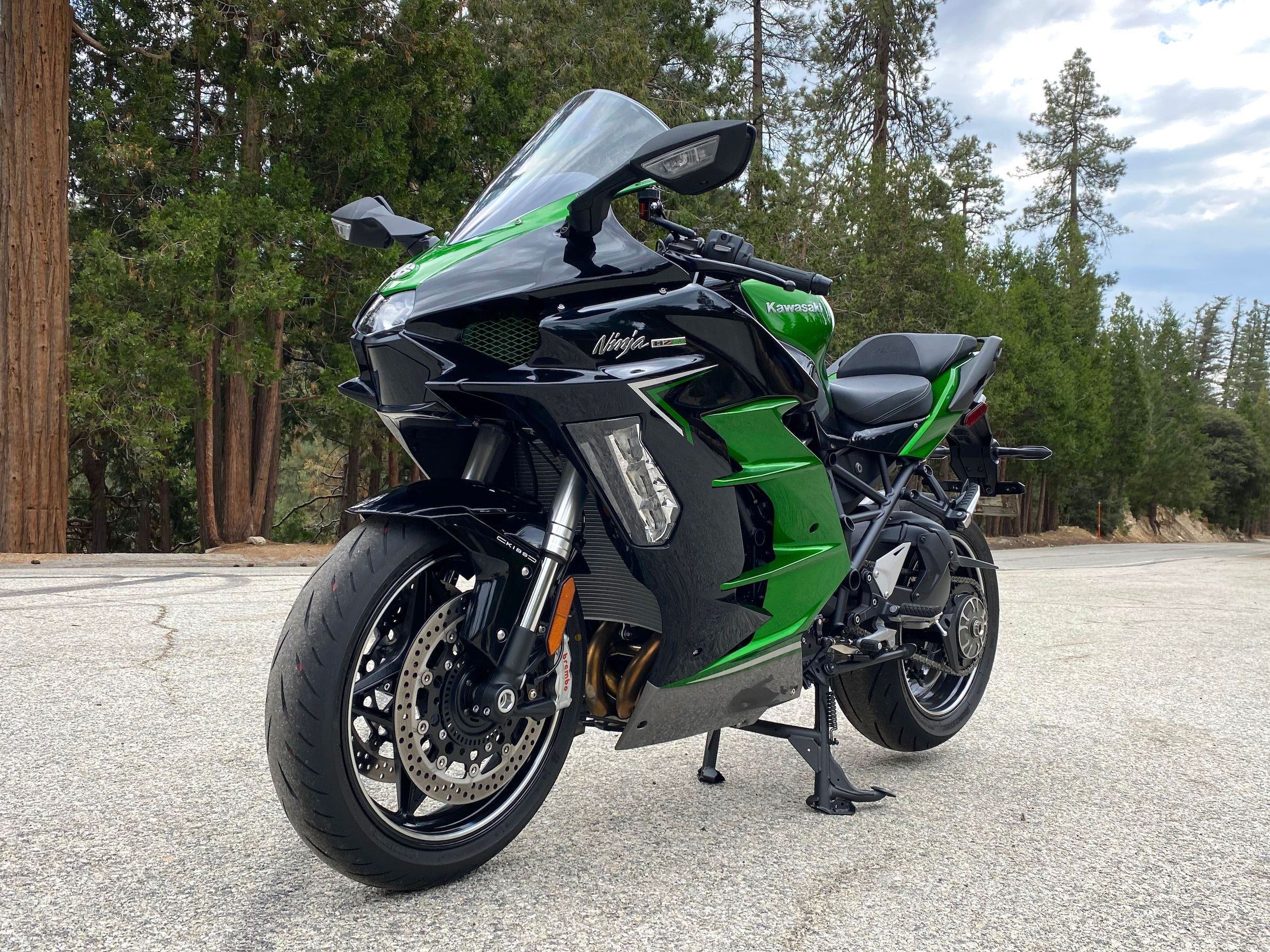
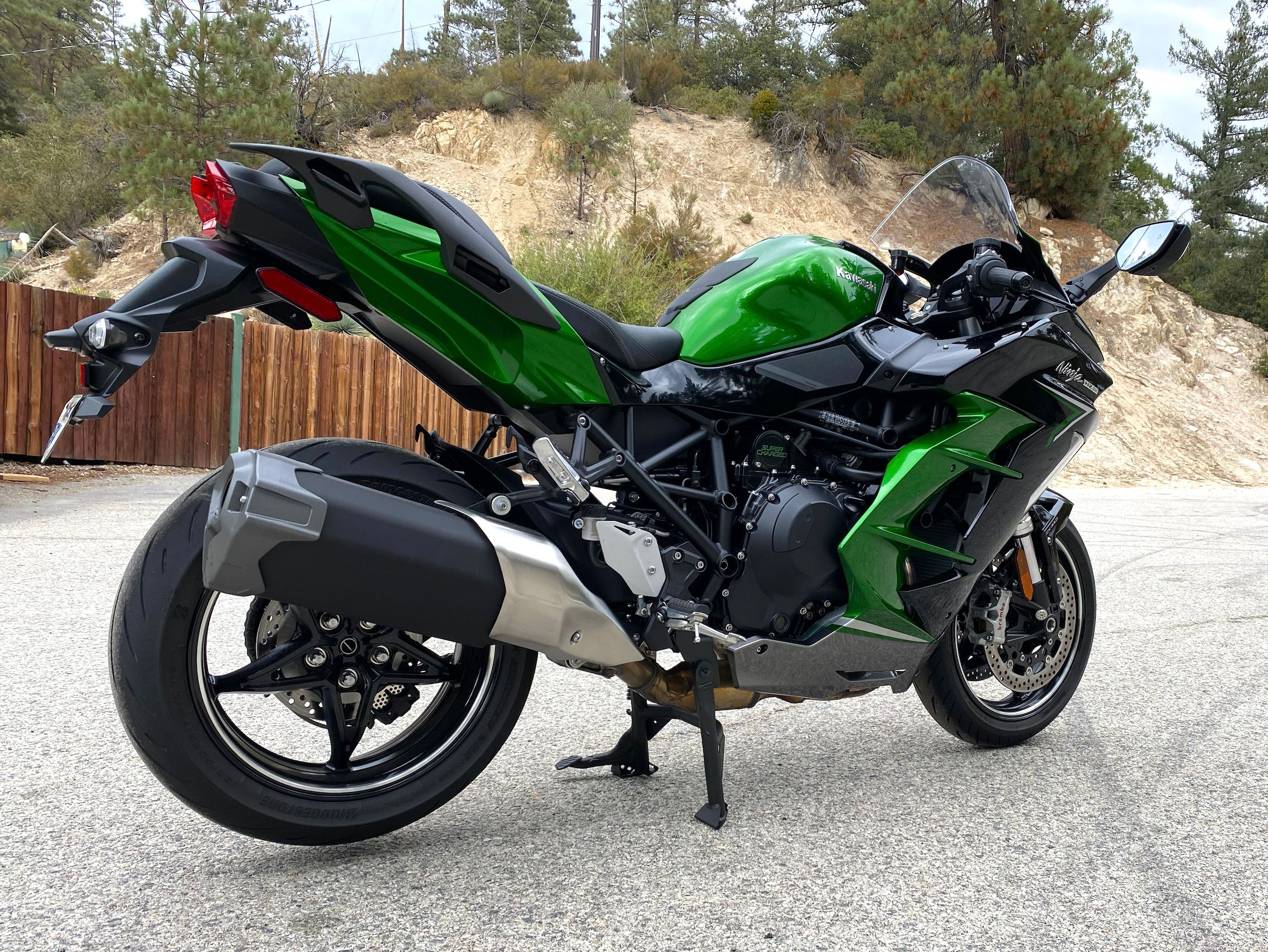
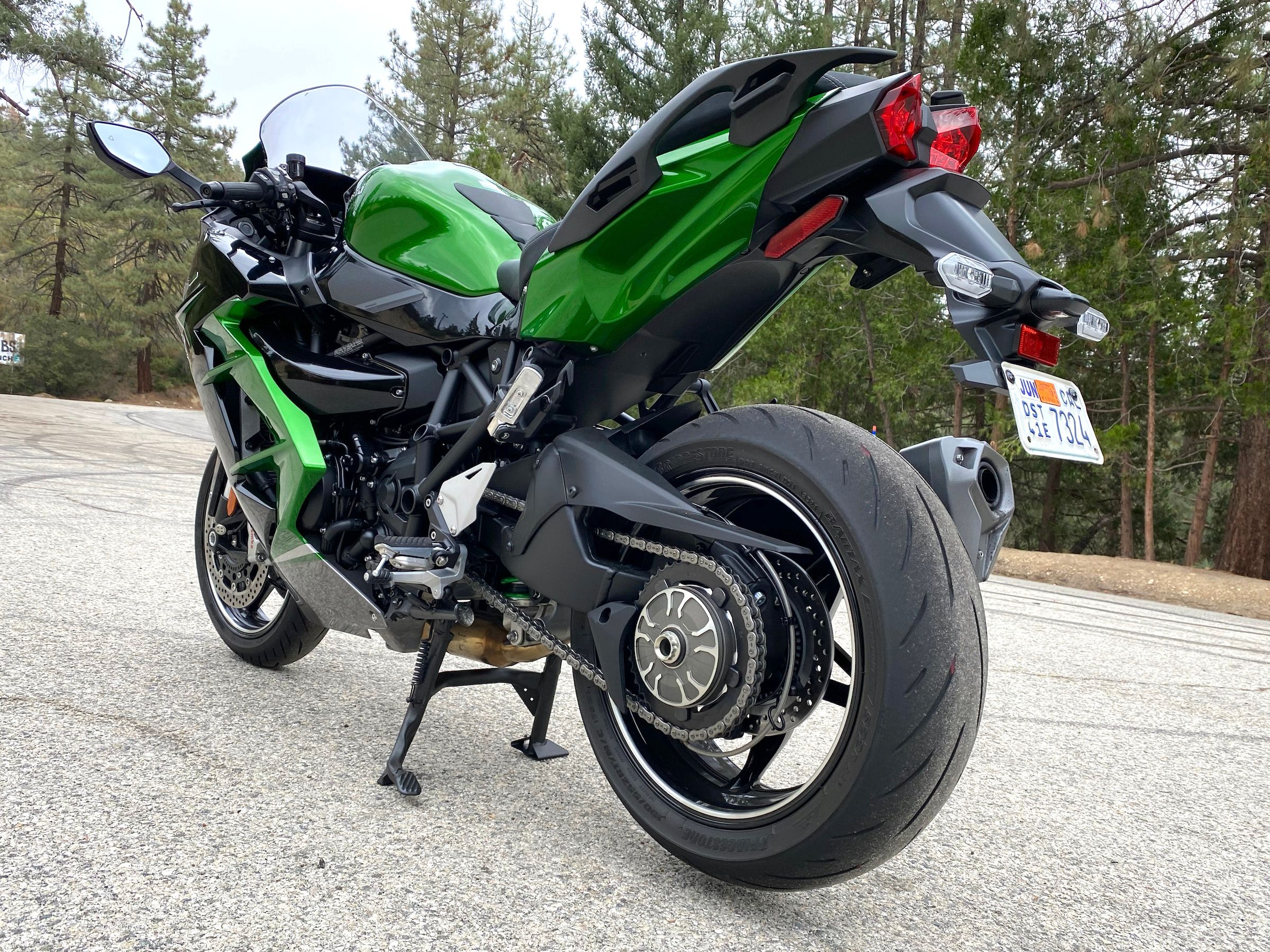
The H2 uses a tubular steel trellis bridge-type frame and a single-sided swingarm. New for 2022, the SX SE has Kawasaki’s semi-active Electronic Control Suspension (KECS) system, incorporating a Showa Skyhook EERA 43mm fork, and a BRCF monoshock. The KECS system works with the H2’s ECU, which uses live data generated by a new Bosch six-axis IMU module to adjust compression and damping in real-time according to road conditions and the chosen rider mode. Four rider modes include Sport, Road, Rain, and a manual setup option providing different suspension maps according to riding styles and weather. Four preset options, selectable from the dash electronically adjust the monoshock's preload for a single rider, with a pillion, and rider or pillion with luggage. Rider mode and preload settings are tunable via ten levels of incremental adjustment.
Brakes And Wheels
With horsepower getting on for 200, the H2 SX SE needs serious anchors. The dual radial-mount 4-piston Brembo Stylema front calipers, which clamp a pair of semi-floating 320 mm discs, provide immense stopping power. Taking care of the rear, an opposed 2-piston caliper and a 250mm disc. The system also uses a new Brembo master cylinder, and lever operation is excellent. Adding additional security, Kawasaki’s KIBS intelligent ABS uses IMU lean angle and traction data to manage intervention and optimize stability. Cast aluminum wheels are now fitted with Bridgestone’s Battlax Hypersport S22 tires, providing excellent grip in the dry with the promise of all-weather performance.
Electronics And Rider Aids
The supercharged H2 series benefits from the most advanced electronics suite yet fitted to a Kawasaki. Central to the suite's functionality is Bosch’s Advanced Rider Assist System (ARAS), which features a forward and rear-facing wide-angle radar. ARAS enables Kawasaki to offer Adaptive Cruise Control (ACC), Forward Collision Warning (FCW), and Blind Spot Detection (BSD) systems for the first time. Active cruise control is starting to appear on more bikes and is undoubtedly useful in states that prohibit lane splitting. The FCW system uses a series of flashing red LEDs to alert the rider to any potential head-on collisions. The blind spot indicator is a welcome addition, illuminating an icon in the side mirrors when a neighboring vehicle passes beyond the projected rearview. Indicating an intention to shift lanes into an area occupied by another vehicle causes the icon to blink, ensuring it catches your attention. Both systems are selectable from the menu.
The H2 also gets an excellent, all-new, 6.5-inch, full-color TFT display. The home screen provides a wealth of information, and the system requires a reasonable investment in time to get fully familiarized with its wide array of options and handlebar control interface. Functions on display include the selected rider and preload mode, ACC operation, quickshifter, engine brake, cornering light, vehicle hold assist, lean angle indicators, ambient air temperature, ice warning, and coolant temperature. The first of two multifunction gauges displays boost pressure along with a choice of throttle application, front brake pressure, or a G-force meter and the second enables riders to scroll through functions including an odometer, trip meters, a new tire pressure monitoring system, boost pressure and intake temperature, fuel consumption, remaining range, average speed, trip time, and battery voltage. All of which are in addition to the standard gear position indicator, tachometer, and digital speedometer.
The updated electronics package also includes Kawasaki’s new smartphone-based infotainment (SPIN) application. SPIN enables smartphone connectivity via Bluetooth and compatible third-party apps to mirror on the TFT display. Basic functions available in the app include telephone, map display, music, calendar, and contacts. The system allows sharing and viewing information, such as fuel gauge, odometer, and the maintenance schedule on the owners' phone, in addition to logging GPS route information and displaying smartphone notices on the cockpit. Users of helmet comms can also download the relevant software to enable hands-free telephone, texting, and music functions. A new USB charging port located under the rear seat provides a place to recharge your phone.
The list of new features adorning the H2 SX SE doesn’t end there. Kawasaki has also added an automated hill braking system: Vehicle Hold Assist (VHA). When at a standstill, a firm application of the rear brake pedal temporarily holds it on. Convenient on inclines that would otherwise require applying the brakes to maintain position. The system automatically disengages the moment you pull away or tap the brakes. The 2022 H2 also gets a keyless ignition system. With the fob in your pocket, turning a knob that could have originated on a stove activates the SX SE's ignition. The proximity fob worked fine, but we did sometimes struggle to work the stove knob, which was often frustratingly fickle. In fairness, after a week of riding, we perfected the deft touch required to awake the beast on demand.
Ergonomics And Styling
A redesigned forward cowling, necessitated by the need to locate the new radar system results in a less extreme and angular design than the edgy H2 sportbike. The new bodywork provides a tad more wind protection, but the SX SE’s slightly higher screen is still inadequate for genuine touring. Kawasaki will sell you a smaller screen, but no larger options are currently available. The new seat is wider and surprisingly comfortable, even on longer rides. While the leg position is fairly neutral with a reasonable bend at the knee, the reach to the clip-on bars is more aggressive and can be tiring on longer hauls, although perfect for carving along your favorite backroads.
Riding Impressions
Our first test of the 2022 Kawasaki H2 SX SE would consist of a slog through LA’s rush hour mêlée. Not the ideal scenario to get acquainted with a machine boasting nearly 750 horses per ton. But any concerns quickly faded and soon replaced with a newfound respect for Kawasaki’s premium sport-tourer. The H2 was a genuine breeze to ride among the halting traffic and imperfect highways. In Road mode, the suspension is supple, soaking up the worst of the holes and bumps, never jolting you out of the seat, although sudden braking evokes no discernable nosedive. Perhaps most striking among our first impressions of the H2 was the incredibly smooth inline four. The balancing is perfect, and even when you find enough road to get the revs deep into the power zone, there is little of the vibration regularly associated with a straight-four configuration. The electronic suspension provides supreme confidence from the moment you pull away and a surprising level of detachment from the road surface, which was less welcome in the canyons we got to carve up later in the test.
At the first sign of a clear highway ahead, the natural inclination to ‘give it the beans’ resulted in immediate, vision-blurring acceleration. The intelligent traction control seamlessly managed the power delivered to the rear wheel while the suspension maintained the H2’s attitude. The torque band was breathtaking, and the shear power catapulting the H2 forward felt eerily effortless. Only the mounting g-forces pushing through your body from the stepped seat provided any notion of speed. Even the H2’s exhaust note revealed little of the manic action at work in the engine, but a grin-inducing audible whine as the supercharger span-up added another element of excitement. We never did find out when the H2 stops pulling, but it is well beyond the speeds we could carry on the street. With so little drama going on, it was all too easy to get carried away only to glance down and find the speedo rapidly climbing above mandatory court appearance velocity.
The downside to all those sensors and cutting-edge electronics is that they add weight to an already substantial machine. The H2 SX SE is a bit of a chubster, weighing in at 590 pounds. For reference, that is a full 75 pounds heavier than the KTM 1250 Super Duke GT. Nevertheless, Kawasaki has done an excellent job centralizing the H2’s mass, and the SX SE exceeded our handling expectations in the canyons. In Road mode, the front end felt a little vague at aggressive cornering angles. But when set to Sport mode, the fork provides better feedback and the confidence to test the Hypersport S22 rubber, revealing the SX SE’s surprising agility. The Stylemas feel like they could stop a train and, just as well, because the bike’s docile feel is utterly at odds with its immense power - corners tend to arrive sooner than expected.
A Luxury Model In Every Sense
The H2 SX SE is available in metallic Emerald Blazed Green and Diablo Black with contrasting Graphite Gray and has an MSRP of $27,500. A significant price tag, certainly, and considerably more expensive than the similarly powered Suzuki Hayabusa and KTM Super Duke GT. But less than the state-of-the-art Ducati Multistrada V4 S. As advanced as any production bike available today, if the latest bells and whistles and astonishing performance are what you want from a motorcycle, the 2022 Kawasaki Ninja H2 SX SE is worth every penny. Not just because it delivers on its promise but because it is also an absolute pleasure to ride. No matter how often you experience the uniquely stealthy yet unrelenting acceleration, you can never tire of it. Bike blowers are here to stay, and although they are unlikely to appear in competition, Kawasaki's H2 won’t be alone for long.

